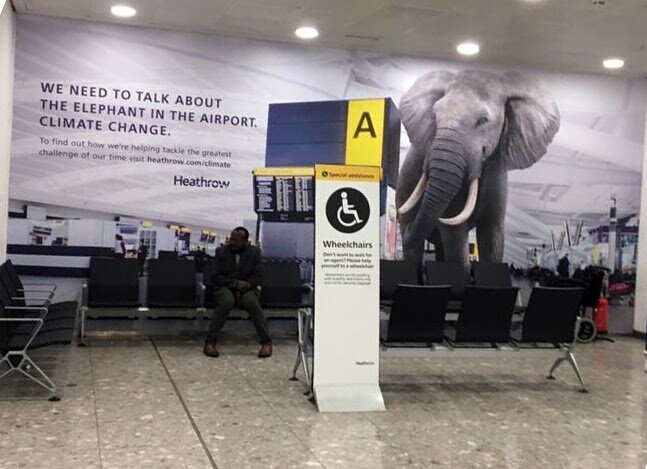Badvert of the Month: Heathrow
With the latest news of Heathrow’s third runway legal approval, our latest badvert of the month about the airport’s apparent climate credentials seems to be a perfect opportunity to discuss everything that’s wrong with it.
A Supreme approval to pollute?
This Wednesday 17th December, the Supreme court ruled against a court judgement in February - the first one of its kind based upon the Paris climate agreement - which concluded legally that a third runway would breach the UK Government’s commitment to limit global warming to 1.5°C degrees above pre-industrial levels. The Supreme Court, on the other hand, has found that there is apparently no conflict of interest between building a new runway and committing to a safe climate.
On the very same day as the airport ruling, in a different landmark case, another court ruled that nine-year old Londoner, Ella Kissi-Debrah, died from the effects of air pollution. The opposition between the two court rulings could not be starker, one potentially leading us further into climate breakdown, and the latter bringing home the very human consequences of air pollution that also disrupts the climate. With air pollution levels repeatedly breaching legal limits, people are left literally dying for clean air as argued in this recent piece for the Ecologist marking ‘Smog Day’.
Whose elephant are we talking about?
Heathrow airport’s pledge to be carbon neutral is a bit like the fossil fuel industry claiming to be part of the solution to tackle climate change. The caption in this advert by Heathrow Airport is however, oddly appropriate. Climate breakdown is indeed the greatest challenge of our time. But contrary to its claims, the airport is not genuinely working to prevent us from falling further down the cliff of climate catastrophe. Heathrow’s plans to tackle climate change revolve around three areas: the airport itself, the airline companies and the passengers. For each of these, as shown on its website, Heathrow’s strategy principally relies on carbon offsetting - a method which is unreliable, not scientifically sound, and subject to numerous false and misleading claims. But carbon offsetting remains high carbon industries’ best “get out of jail free card”. Another strategy pushed by Heathrow is to promote biofuels as a means to cut carbon emissions from flights. Besides biofuels’ seemingly dubious green and ethical credentials, airlines mostly use biofuels as a way to greenwash their image. This was the case with Dutch airline KLM whose fleet used no more than 1% of biofuels despite its aggressive marketing campaign about it.
The elephant in the picture here is actually Heathrow’s carbon-heavy flights which the airport plans on increasing with a third runway (forecasting 700 more flights per day) despite having already doubled its number of passengers since 1990 (from 43 million to 80 million). The relevant question for Heathrow to answer is how can it be part of a national strategy of reaching zero carbon when its entire business model relies on continuing carbon emissions from an ever-increasing amount of flights?
Heads buried under the tarmac
The UK government committed via the Paris climate agreement to meet net zero carbon emissions by 2050. According to the Climate Change Committee itself, the UK Government’s adviser on climate-related matters, there is “no net expansion of airports” that can be compatible with meeting global emissions reduction targets. Besides the financial viability of Heathrow’s third runway can be contested on various grounds. One of the greatest points of contention is how the airport, one of the most expensive in the world, will get airlines to pay for “landing fees” in order to recover from the costs incurred due to the Covid-19 pandemic.
The aviation sector is clinging on as one of the hardest hit industries, since the start of the pandemic, with flights mostly ground to a halt across the globe. Even regardless of this, the industry seems not to have provisioned for long term inevitable reductions in flying due to the climate emergency, and produced no proper plans for conversion to help protect its workforce. Airlines have instead actively and successfully lobbied governments to benefit from bailout packages, which have been granted with no climate strings nor workers’ rights guarantees attached. This financial support did not however prevent companies from laying off workers en masse. Heathrow’s promises of job creation with the prospect of a third runway rings hollow when the airport’s union, Unite, is planning industrial action during December to protest against pay cuts and “fire & rehire” plans.
Hype around airport expansion at this time, and adverts making unreliable claims about carbon neutrality help neither the climate emergency nor workers in the industry. Rather we need to end such misleading advertising and actively support people working in high carbon sectors into green jobs in the growing low carbon sectors.

